Clan Campbell Tales
Table of Contents
Campbells of Lochaber
In Lochaber, where some Campbell families have lived for many years, there is still a Catholic church (recently restored) from early times. Many of the Campbell families in that area of Scotland were always Catholic as it was a wild area and the reformation of 1560 did not reach all corners of Scotland. The outer Isles were also areas where Catholic communities survived and there were Campbells there also. Travel in the western or coastal Highlands, and certainly the islands, was most often by boat, where possible, and so travel was relatively easy despite no roads. People did move about a lot, particularly younger sons who would not inherit a farm or a tenancy.
 Some people went to other areas in the train of a daughter of a chief marrying the son of another chief, as her bodyguard and "servitor" (better educated helpers rather than "servant.") This happened with Campbells going to the Isle of Skye to live among the MacLeods.
Some people went to other areas in the train of a daughter of a chief marrying the son of another chief, as her bodyguard and "servitor" (better educated helpers rather than "servant.") This happened with Campbells going to the Isle of Skye to live among the MacLeods.
The story of how the Campbells came to Lochaber is that they were descendants of Campbells from the district of Glassary in Argyll. A "crowner" (local official - what he did has been lost to knowledge) began to bother Campbell's wife. So he hid up on the hillside and watched his door. When the crowner was coming and when he saw the crowner bother her he ran down and killed him, so they had to leave Argyll.
They went to Lochaber and are said to have been the bodyguards of MacDonald of Keppoch. They also acted as foster-parents to different members of that family.
The Gaelic bard Iain Lom, who was violently anti-Campbell in the 17th century Civil Wars, is believed to have been one of them, or descended from them and he was taken to task for his vitriol by other Gaelic bards for being too extreme. It was thought it was because he was going against his kin that he was so wild.
This family is known as the Glassarach or MacGlassarach Campbells because they originated from Glassary, now Kilmichael Glassary in mid Argyll. Thus, the name MacGlasrich can be found on the Clan Campbell septs. One branch of these Campbells settled in Breadalbane. According to the Black Book of Taymouth, Donald McGlassrich in Foss gave a bond of manrent to Campbell of Glenorchy in 1560. This branch of the family apparently did not last, for Black states that, "the family died out on Loch Tayside as a result of a curse laid on them by a witch."
Cailleach Bheara & Loch Awe
 The season from Samhain (the Celtic New Year, also referred to as "Halloween") to Imbolc (or "Bridget's Day"), February 1, was called by Celtic people "the time of the little sun." In Celtic folklore, this season is ruled by the one-eyed Cailleach Bheara, also called "Mag Moullach" and the "Storm Hag."
The season from Samhain (the Celtic New Year, also referred to as "Halloween") to Imbolc (or "Bridget's Day"), February 1, was called by Celtic people "the time of the little sun." In Celtic folklore, this season is ruled by the one-eyed Cailleach Bheara, also called "Mag Moullach" and the "Storm Hag."
According to the Celts her home was Ben Nevis. It was she who formed the Inner Hebrides by dropping peat and rocks into the sea and who ushered in winter by washing her clothes in the Corrieveckan, a huge whirlpool between the isles of Jura and Scarpa. Stories abound throughout Scotland concerning the Hag's hand in forming many lochs and bens, including Loch Awe, the original homeland of the Campbells.
The Cailleach Bheara once lived on the Mull of Kintyre, the southernmost tip of the major peninsula in Argyll. Each day she would take her cow to Ben Cruachan to graze. The only water available there was from a magic well, which was covered by a huge granite slab.
Upon her arrival on Ben Cruachan, the Hag would lift the granite slab and set it aside. And each evening she would replace it, as it was known that, if left uncovered, the magical well would flood the world.
One fine day she fell asleep on the hillside as her cow grazed. She didn't rouse until evening, when she was awakened by the roaring of a torrent of water. Although she hurriedly replaced the granite slab, by the light of the moon she could see that the entire glen below Ben Cruachan had been turned into what we now call Loch Awe.
Clach Nan Caimbeulach
From Romantic Lochaber
by Donald. B. MacCulloch
"The hill road known as the Lundavra road branches to the left between stone walls from the main Fort William road about 100 yards south of the town court house . . . At the highest council house of Fort William on this steep road there is a burn or stream now frequently called the AStonesh Burn, but its earlier name was Allt nan Dathadairean, meaning the dyers burn, probably relating to the small industry of wool and cloth dying in Fort William which dates about the time of the Jacobite rising of 1745.
"Around the upper reaches of this stream and on the east side of the road, the moorland is known as Achan a'chath meaning the little field of the fight, or battle, because it was here that some Campbell clansmen made a stand against their pursuers when fleeing from the battle of Inverlochy in 1645.
"A remnant of Argyll's clansmen hastened over this road . . . in their escape from the battle of Inverlochy in 1645, when there would have been a track, not a road. They were pursued by some of the MacDonalds of Montrose's army to a spot about half mile east of the branch road to Loch Lundavra, but having a good start the Campbells escaped.
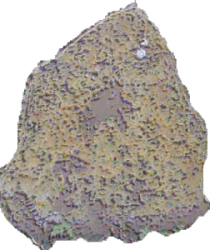 "To mark the spot where they turned back, the MacDonalds raised a large stone on the south side of the track and close to it. The stone became known as Clach nan Caimbeulach (stone of the Campbells), and is mentioned in The New Statistical Account of Scotland(1835).
"To mark the spot where they turned back, the MacDonalds raised a large stone on the south side of the track and close to it. The stone became known as Clach nan Caimbeulach (stone of the Campbells), and is mentioned in The New Statistical Account of Scotland(1835).
"Later, a cairn of stones was erected close to this large stone, and on the same side of the road to indicate its exact position, because there are a number of somewhat similar large stones lying around nearby on the moor.
"According to the traditional custom, every MacDonald or those who sympathized with Montrose who passes this way should add a stone to the cairn, and every Campbell or those who sympathized with Argyll should throw down a stone from the cairn.
"The winter storms have reduced the cairn to a low heap of stones almost undistinguishable as a cairn, and the principal stone seems to have sunk into the peat and heather so far that it is no more conspicuous than other stone nearby.
"Very few persons now traverse this track and still fewer will be aware of the cairn."
Inveraray Ghost Story
Many of you may know the legend commonly referred to as the "Ticonderoga ghost story." You might also know that, in addition to Duncan Campbell of Inverawe, many Campbells were killed or wounded in the famous Black Watch assault on French forces. But did you know that there is another Scottish legend connected to that battle?
On 10 July 1758, a doctor by the name of William Hart experienced 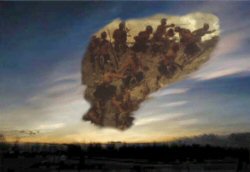 a strange vision while at Inverary Castle. He was walking the castle grounds, along with a friend and his servant, when his friend gasped. Turning to see what had so upset his friend, he was met with the sight of a battle taking place in the sky. The vision appeared to show Highland forces attacking French troops stationed behind battlements. Over and over again the highlanders attacked, only to have their ranks devastated by musket fire.
a strange vision while at Inverary Castle. He was walking the castle grounds, along with a friend and his servant, when his friend gasped. Turning to see what had so upset his friend, he was met with the sight of a battle taking place in the sky. The vision appeared to show Highland forces attacking French troops stationed behind battlements. Over and over again the highlanders attacked, only to have their ranks devastated by musket fire.
Later that day, two young Campbell ladies arrived in Inverary and described having witnessed a battle in the sky. This clearly frightened them and everyone involved were at a loss as to what they had witnessed.
Weeks later, official news arrived in Inverary that more than 300 men of the Black Watch had been killed in an assault on a French held fort in North America. The fort was called "Ticonderoga" and the date had been 10 July 1758
Escape from Inveryne
 Before Castle Toward was built, on the southern end of the East Cowal peninsula, the home of the chief of the Lamonts was at Inveryne. Inveryne is near the present day Kilfinan, on the eastern shore of Loch Fyne, looking across to Knapdale.
Before Castle Toward was built, on the southern end of the East Cowal peninsula, the home of the chief of the Lamonts was at Inveryne. Inveryne is near the present day Kilfinan, on the eastern shore of Loch Fyne, looking across to Knapdale.
During one of the many Highland conflicts, the Lamonts managed to take 15 Campbells prisoner and had them held at Inveryne, in a high tower room reached only by a narrow stair on which a guard had been placed.
After several days of captivity, the Campbells made an escape plan. That evening, they began to sing, and they continued to sing until it was far into the night. But their singing was simply subterfuge, for while they sang, they took their blankets and ripped and tied them together to make a rope. The guards on watch gathered at the bottom of the stair to listen to the songs, and were not able to see what the prisoners were doing.
The prisoners secured one end of the rope and threw out the other end out the single window. One by one, they lowered themselves to the ground and melted into the evening. The guards on watch noticed that fewer and fewer voices were joined in song, but must have believed that the prisoners were going to bed. Finally, they heard but one very sweet voice, so beautiful that they listened raptly to his song. When he had sung his song to the end he said in a loud voice, "since you have all gone to bed, I shall go to bed also" and off he went out the window, down the rope and followed the rest into the mist.
The next day, when the Lamonts went to see their prisoners, there was not one of them left to be found."
God Bless the Duke of Argyll
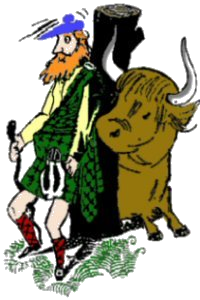 How many times have you scratched your back against a tree, post, or other object, being unable to reach an itch? An old story, confirmed by the 12th Duke of Argyll, is that the eighth Duke, on seeing cattle and sheep being irritated by flies and other beasties dining on their nether regions, erected posts on his estate against which the animals could rub and scratch themselves. This caught the attention of the nation and whenever Scots would scratch their backs against a post or other object, it became a custom to use the phrase, "God bless the Duke of Argyll."
How many times have you scratched your back against a tree, post, or other object, being unable to reach an itch? An old story, confirmed by the 12th Duke of Argyll, is that the eighth Duke, on seeing cattle and sheep being irritated by flies and other beasties dining on their nether regions, erected posts on his estate against which the animals could rub and scratch themselves. This caught the attention of the nation and whenever Scots would scratch their backs against a post or other object, it became a custom to use the phrase, "God bless the Duke of Argyll."
Tigh Bhròinein
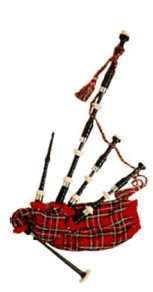 One day long ago, Campbell of Barbreck was visiting his cousin, Campbell of Craignish. While Craignish had long kept the old tradition of retaining a piper, his cousin Barbreck, although he could more than afford the cost, would not spend the money to keep one.
One day long ago, Campbell of Barbreck was visiting his cousin, Campbell of Craignish. While Craignish had long kept the old tradition of retaining a piper, his cousin Barbreck, although he could more than afford the cost, would not spend the money to keep one.
As he was about to leave, he met his cousin's piper and said, "The New Year will be upon us soon. After you have played a proper salute for my cousin on New Year's morning, I would much appreciate you coming to Barbreck and playing for me. As you know, I do not have a piper. Perhaps you could spend the day with us."
The piper promised to visit and after playing for his master on New Year's day, went to Barbreck with his pipes. He played and played until he was quite tired. Having to hint strongly that he was both hungry and thirsty, he was finally given something to eat and drink. The amount of food was meager, and the drink was not much better.
Before long, tiring of his inhospitable host, the piper stated that he must leave. "Give us one more tune before you go," said Barbreck. "I will that," said the piper and began to play the tune, Tigh Bhròinein, "House of the Miserly one."
And for long years after, Barbreck's home was called Tigh Bhròinein.
Campbell vs. MacDonald
Scottish history has often been simplified, with the implications that undying enmity between clans, particularly the Campbells and MacDonalds, was the norm. Here is a story that belies such a simplistic view.
In 1647, during the Scottish civil war, Campbell of Kilberry was called to arms by Argyll. Apparently tired of having to march his tenants off for another foray, he none-the-less prepared to do so. Arriving in Tarbert, he found his brother-in-law, MacDonald of Largie, who, along with his followers, was making ready to march off to support the other side in the conflict. The two gentlemen retired to an evening of a few drams and exchanges of information about their respective families.
 In the morning the two awoke to find, much to their embarrassment, that their troops had left without them. Largie immediately decided to take action and "kidnapped" Kilberry, taking him off to Kintyre. The Lady of Largie, nee Campbell of Kilberry, was less than enthused, as she was in the middle of cleaning her home. The two stayed there for a while until she made it too uncomfortable to remain. Kilberry single-handedly "kidnapped" Largie and set off for home in a small boat.
In the morning the two awoke to find, much to their embarrassment, that their troops had left without them. Largie immediately decided to take action and "kidnapped" Kilberry, taking him off to Kintyre. The Lady of Largie, nee Campbell of Kilberry, was less than enthused, as she was in the middle of cleaning her home. The two stayed there for a while until she made it too uncomfortable to remain. Kilberry single-handedly "kidnapped" Largie and set off for home in a small boat.
When they arrived, Mrs. Campbell, nee MacDonald, was less than welcoming. It seemed that during Kilberry's absence his home had been besieged by Islemen for three days. The siege ended only when she had lowered a barrel of ale over the wall. The Islemen drank up and wandered off to cause mischief elsewhere. Mrs. Campbell was rather upset that, while her home was under siege, these two were sitting around comfortably eating, drinking, and exchanging stories.
So, back to Largie they went. Only to return once again to Kilberry. Evidently, these sojourns might have continued without interruption. However, they were seized by MacNeill of Gigha, who ardently threatened to denounce the two slackards to their respective sides in the conflict. Kilberry and Largie need not have worried, though. Returning to Kilberry with the two gentlemen, MacNeill fell in love with one of Kilberry's daughters and joined the two in their boycott of the conflict.
The Ticonderoga Ghost
One evening in 1755, Duncan Campbell of Inverawe was walking near his castle when a stranger, whose kilt was torn and bloody, approached him. The stranger begged Duncan to hide him as he had killed a man in a dispute and was just ahead of his pursuers. Duncan led him to a recess in the castle and swore that he would shelter the stranger.
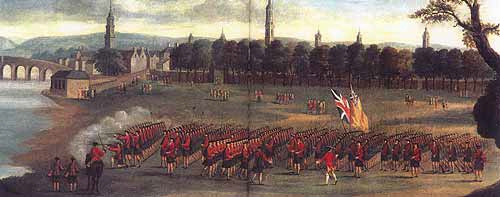 A short time later the stranger's pursuers arrived at Inverawe. They informed Duncan that a man had killed Duncan's cousin (some versions say his foster- brother), that they were giving chase and asked Duncan if he had seen anyone. Remembering his oath to the stranger, Duncan declared that he had seen none.
A short time later the stranger's pursuers arrived at Inverawe. They informed Duncan that a man had killed Duncan's cousin (some versions say his foster- brother), that they were giving chase and asked Duncan if he had seen anyone. Remembering his oath to the stranger, Duncan declared that he had seen none.
In the middle of the night Duncan woke in a state of terror. Standing over him was the ghost of his murdered cousin. "Inverawe, blood has been shed. Avenge my death!" wailed the ghost and faded away
The next morning Duncan went to the stranger's hiding place and informed him that he could no longer give him shelter as it was Duncan's kinsman that the stranger had slain. "You have sworn to shelter me," answered the stranger. Duncan, torn between loyalty to his kin and having given his word, decided on a compromise. Once again promising not to betray the stranger, Duncan led him to Ben Cruachan and hid him in a cave.
That night, as Duncan lay tossing, the ghost appeared again. "Inverawe, blood has been shed. Avenge my death," cried the ghost. Duncan refused. "I have sworn to give the man shelter," he replied to the ghost of his cousin. Once more the ghost faded away.
The third evening the ghost returned, again demanding that Duncan avenge him. When Duncan once more refused, the ghost responded, "Farewell, then. We shall meet again at Ticonderoga." The strange name meant nothing to Duncan, or anyone else.
Three years later Duncan, now a major in the Black Watch and second in command, was sent with his regiment to fight the French in North America. His fellow officers were well aware of both Duncan's story of his cousin's ghost and his terror at the name of Ticonderoga. The regiment received orders to attack Fort Carillon (the French name for the fort) and they kept from Duncan the fact that this was also known by the natives as Ticonderoga.
The evening before the attack, Duncan received another visit from his cousin's ghost. The next morning he awoke and went to his brother officers saying, "You have all deceived me. He came to my tent last night and told me that this is Ticonderoga! I shall die here."
Duncan was wounded in the battle that day and died of blood poisoning three days later.
The Return of Black Colin
In 1400, a son was born to Sir Duncan Campbell and his wife Margaret, a granddaughter of King Robert III. His name was Colin, and was known to the Campbells of Glen Orchy as Cailean dubh na Roimhe - Black Colin of Rome. Black Colin was responsible for much of the building of Kilchurn Castle, which sits beneath Cruachan Ben at the northern end of Loch Awe.
The reference to Rome in his title signifies that he visited there three times. An account from the Black Book of Taymouth refers to a stone that he carried on his journeys, "Ane stone of the quantity of a hen's egg set in silver, whilk Sir Coline Campbell first Laird of Glenorchy woir when he fought in battel at Rhodes agaynst the Turks, he being one of the knychts of Rhodes."
The Scots were fierce Crusaders and it was not unusual for them to carry charms with them on their journeys to the Holy Land. The stone mentioned above was the one that Black Colin took with him on his journey as a Crusader. Which brings us to the story at hand.
 Colin learned of the Crusades and vowed to go. His young wife, Margaret, was not keen to see him leave, but Colin was adamant. Before he left, he had a ring made inscribed with both their names. He broke the ring in two and gave Margaret one half saying, "If you come to receive my half of the ring you will know me to be dead." He then took ship at Leith for Rome. After an audience with the Pope, he left to join the knights fighting at Rhodes.
Colin learned of the Crusades and vowed to go. His young wife, Margaret, was not keen to see him leave, but Colin was adamant. Before he left, he had a ring made inscribed with both their names. He broke the ring in two and gave Margaret one half saying, "If you come to receive my half of the ring you will know me to be dead." He then took ship at Leith for Rome. After an audience with the Pope, he left to join the knights fighting at Rhodes.
Seven years passed. Lady Margaret was besieged by suitors during that time who insisted that Colin must be dead. She replied that she had never received the token that Colin had promised to have sent upon his death and that he must, therefore, still be alive.
Unknown to Lady Margaret, one of her suitors, Baron Neil MacCorquodale, had intercepted messages that Colin had sent, killing the messengers. He remained steadfast in his pursuit of her, despite her refusal to marry him, as the lands of Glen Orchy would add nicely to his Barony.
Despite her refusal to describe the token, MacCorquodale came up with a plan. He arrived to visit her with a raggedly dressed man who said that he bore a letter with news for the Lady of Glen Orchy. When she opened it she found that it described the death of her husband.
"Is there no token?" she asked.
"There is no token," said the man. "But I received word in Rome from the only survivor of the Campbells who accompanied your husband. He told me that, as he lay dying, your lord entrusted a token to this man. However, the man was sorely wounded in a battle with the Saracens after that and the token was taken from him."
Lady Margaret was overwhelmed by grief. But, as time went by, MacCorquodale remained attentive and continued to press for her hand. Finally, she agreed to marry him as soon as the tower of Kilchurn Castle was completed.
Despite her agreement, she still retained hope that Colin would return. She ordered the workmen to build as slowly as possible.
Another woman also had doubts about Colin's death, it was his old foster-mother. She disliked and mistrusted MacCorquodale, and hated the idea of him taking her lord's place. She called her eldest son to her and told him to go to Rome and find out what he could about Colin.
Colin's foster-brother made his way to Rome, where he came face to face with Colin. He told him what was occurring at home and they immediately took ship for Scotland.
When they landed, Colin sent his foster-brother home alone. He told him to tell his mother that he had been unsuccessful and said that he, Colin, would follow in disguise. Dressed as a beggar, Colin followed him to the home of his elderly foster-mother. Unrecognized by her, Colin asked for hospitality of the house, which was readily granted. Colin then revealed himself to his foster-mother and asked for news of the wedding. She told him that it was planned for the following day.
The next day dawned and found Colin making his way to the castle in his beggar's disguise. He arrived to find that the wedding feast was under way and entered the hall, seating himself at the lowest table. When wine was brought to the table he announced in a loud voice that he would only accept a drink from the Lady of Glen Orchy, herself.
While some found this declaration by a beggar offensive, the lady made her way to the apparent beggar and offered him a cup. Colin, took the cup from her hand, drained it in one gulp, and handed it back to her. Margaret looked down into the cup, where she saw his half of the token ring. Startled, she looked at the beggar, who raised his eyes to meet hers, and Margaret saw her husband who had left so many years before.
Their reunion was a time of great joy for the two of them, as it was for Colin's clansmen. Obviously, the wedding was called off and the wedding feast turned into a celebration of Colin's return. The news was spread throughout Glen Orchy.
MacCorquodale was terrified at Colin's return but, as he had already accepted the hospitality of the house, he was allowed to return to his own lands unharmed. That did not, however, stop Colin's clansmen from later hunting MacCorquodale down and killing him for his duplicity.
Lady's Rock
On the trip out of Oban Bay, heading toward Tobermory on Mull, one passes the southern tip of Lismore and a rock that would barely be noticed but for the small light tower that sits atop it. This is Lady's Rock. A small rock that, while exposed during low tide, is completely submerged at high tide. How it came by its name follows.
 During the early 1500's, life was uncertain in the western Highlands. The rising power of the Campbells, a direct result of their constant support of the King's interests in the Highlands, made many uneasy. Added to this, was the continued intransigence of Clan Donald toward the Crown. A situation which was central to the conflict between these two great Highland clans and which impacted on many of the other clans in the area, among whom were the Macleans on the Isle of Mull.
During the early 1500's, life was uncertain in the western Highlands. The rising power of the Campbells, a direct result of their constant support of the King's interests in the Highlands, made many uneasy. Added to this, was the continued intransigence of Clan Donald toward the Crown. A situation which was central to the conflict between these two great Highland clans and which impacted on many of the other clans in the area, among whom were the Macleans on the Isle of Mull.
The MacDonalds and Macleans had banded together against the rising power of the Campbells, ravaging some of the Campbells' richest lands. Soon after this the son of the Clan Donald Chief married a sister of Colin Campbell, the 3rd Earl of Argyll. Finding himself isolated politically, Lachlan Cattanach, 11th Chief of the Clan Maclean followed suit, and wed another sister of Argyll, Lady Elizabeth Campbell.
What followed is unclear. One story is that Lady Elizabeth was barren and did not provide him with a son; another that Lachlan Cattanach had supported MacDonald of Lochalsh in his attempt to proclaim himself Lord of the Isles and resented Earl Colin's role in suppressing the uprising; another that Lady Elizabeth had twice sought to take Lachlan's life. But history tells us that in 1523, Lachlan Cattanach abandoned his wife on what is now known as Lady's Rock as the tide was coming in. He returned home to Duart Castle and dispatched messengers to Earl Colin in Inveraray to say that his sister had been lost at sea.
Unbeknownst to the Chief of the Maclean's, things weren't going exactly as planned. As his wife stood helplessly on the rock, watching the tide rise, a small ship sailed around a point. She was overjoyed to discover the ship manned by several of her clansmen, who swept her off the rock and sailed for Inveraray with the tide.
Several days later, when Lachlan Cattanach's messengers arrived in Inveraray with the news that Lady Elizabeth was lost at see, they found her seated at the table with Earl Colin.
The Campbell clansmen were quick to anger, but were held in check by their Chief. However, memories last for a long time in the Highlands. Several years later Lady Elizabeth's other brother, John Campbell of Cawdor, found Lachlan Maclean in Edinburgh. He followed him to his lodgings, and there, stabbed Lachlan Maclean to death as he lay in his bed, affording him as much opportunity to defend himself as Maclean had Lady Elizabeth.
It was from this story that the poet, Thomas Campbell, formed his poem, "Glenara."
"I dreamt of my lady, I dreamt of her grief,
I dreamt that her lord was a barbarous chief;
On a rock of the ocean fair Ellen did seem;
Glenara! Glenara! now read me my dream!"
Gray John & a Campbell Pipe Tune
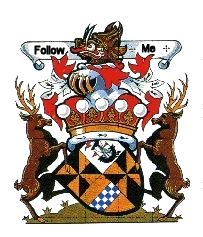 In 1669, Iain Glas, "Gray John Campbell," 11th laird of Glenorchy, was asked by the King's Privy Council to travel to Caithness in the north of Scotland. There he was to stamp out plundering by William Sinclair of Dunbeath and his followers. He was joined by part of the King's Guard, Lord Linlithgow's foot regiment, and later, George (Sinclair), 6th Earl of Caithness.
In 1669, Iain Glas, "Gray John Campbell," 11th laird of Glenorchy, was asked by the King's Privy Council to travel to Caithness in the north of Scotland. There he was to stamp out plundering by William Sinclair of Dunbeath and his followers. He was joined by part of the King's Guard, Lord Linlithgow's foot regiment, and later, George (Sinclair), 6th Earl of Caithness.
They took Dunbeath Castle and carried out the Privy Council's orders. But while there, an opportune situation appeared.
The Earl of Caithness, who was married to a daughter of the Marquis of Argyll, was deeply in debt. Gray John lent him money and continued to do so until he was in control of Caithness' finances. By 1672, the Earl conveyed his "estates and heritable jurisdictions" to Gray John in writing. In return for this, Gray John agreed to pay the Earl £1,000 a year for the remainder of his life.
Gray John waited until the Earl died in 1676 and then stepped forward to claim the Caithness title. His claim was approved by King Charles II, which surprised many people. However, when George Sinclair of Keiss, the next in line for the earldom, protested, the king reversed his decision.
In consolation, in 1681 King Charles II made Gray John Earl of Breadalbane and Holland, Viscount of Tay and Paintland, Lord Glen Orchy, Benderalloch, Ormalie and Wick.
This did not satisfy him though and he decided to take the Caithness lands by force, as he regarded them as his own. He gathered an army of 700 men, requiring that each be able to leap over a double plaid (4' 9") in full armor and gear and marched them into Caithness.
There is a traditional tale told by Breadalbane Campbells that they allowed a train of pack ponies carrying whiskey to be captured by the Sinclairs and, after the Sinclairs had drunk themselves into inebriation, had fallen on them. In any event, the Campbells routed Sinclairs at Allt nam Mearlach, the Burn of Thieves. Gray John began collecting taxes in Caithness after the battle, but his men were so harassed by the Sinclairs that they were forced to withdraw. However, eventually he was able to seize control of the lands, and gathered rents from them during the rest of his lifetime.
It was from the battle at Allt nam Mearlach that one of the most famous of Campbell pipe tunes arose. Known as "Breadalbane's March" (or Salute), the original Gaelic title, "Tha Bodaich nam Brigais," addressed with derision that the Sinclairs not only ran, but were not in the kilt. Composed by Finlay MacIvor, Campbell of Glen Lyon's piper, as he watched the Sinclair's turn and run, he wrote . . .
"Tha bodach nam brigais,
Nam brigais, nam brigais,
Tha bodach nam brigais
A nis retréuta.
The carles (old men) with the breeks (trousers),
the breeks, the breeks,
The carles with the breeks
Are flying before us."
It was to this air that Sir Walter Scott later wrote the words to the song, "Hail to the Chief."



 Clan Campbell Society (North America)
Clan Campbell Society (North America)